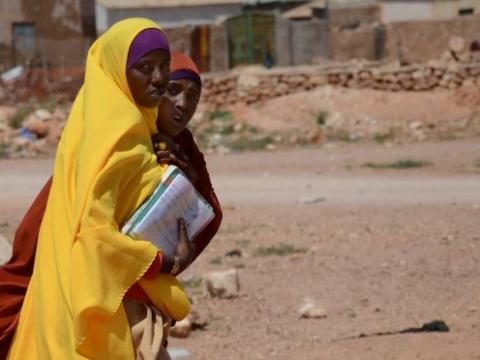Hard Lessons Shape a Better Future

Story by John Schenk, Global Centre Communications, Manager Commnications Academy
The new benchmark in development thinking is resilience, which is as simple as the dictionary definition, i.e. the ability to spring back into shape, to recover from difficulties. It gets complex because no two contexts are exactly the same and the factors to be weighed in program planning are manifold.
But when someone told me there is a current discussion about whether we make communities resilient, or we strengthen the existing resilience of communities, it seemed a moot point, as long as there are results.
Then I bounced over three hours of the worst roads (no exaggeration) I’ve travelled in 28 years with World Vision to in a tiny village in Somaliland. Mohammad Ismail, 34, village head man and store owner, showed me it is about strengthening, though he had no clue there was even a debate.
Mohammad spent some years in a refugee camp across the border in Ethiopia. He called the experience humiliating: “We went from eating what came from the work of our own hands to eating what people handed us.”
Two good things did happen in the camp. He went to school and he witnessed people working together. He weighed this against his strongest childhood memories as a nomadic herder, the bloodshed as clans fought over scarce water and vegetation.
He concluded it was important to convince families to gather in one place along an important road, to form a village in their home region. They agreed though they knew it would be years before the village was successful.
The resilience mantra is people absorb shocks, adapt and transform themselves. Mohammad and his neighbours were doing just that when World Vision arrived nearly two years ago. We fell into step and walked with them, responding to their felt needs and strengthening their efforts.
The results have been giant strides forward. “We had a vision for our village but there was often no time to give,” he explained. In the dry season, days were spent traveling 10 to 25 kilometers for water. Men dug 10-meter wells to reach it, children herded the animals to drink it and women fetched the water back to the village. There was no time for anything but the pursuit of water.
Now a dam provides water year round. Seventy-eight children are learning in a two-room school. There are latrines, which people are replicating. Three businesses – Mohammad’s store, a tea room and a pharmacy – have sprung from the cash World Vision paid community members for building the school. The 20 families of Kalabaydh are talking about their village one day becoming a town.
School teacher Said Mumin, 45, measures the improvements in the dreams of his students: “They are talking about becoming doctors, engineers, even president (of the country). They don’t understand what all these things mean but the point is they want to become leaders. I am proud of them. They want to change their community.”
Says Mohammad: “You know what is given to you by others eventually will stop. If you live from the work of your own hands you know when you work more, you can have more.”